High-power Lasers
By Todd Ditmire
The invention of the laser 50 years ago has led to the latest generation of devices, with power bursts thousands of times that of the nation’s entire electrical grid
The invention of the laser 50 years ago has led to the latest generation of devices, with power bursts thousands of times that of the nation’s entire electrical grid

DOI: 10.1511/2010.86.394
Lasers are remarkable devices. Their ability to produce a sharp, bright beam of light of a well-defined color is something that amazes students to this day. It could be argued that, after the transistor, the laser has been the most significant technological invention since World War II.
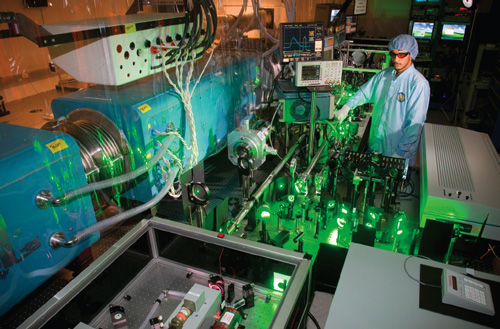
Photograph courtesy of Todd Ditmire.
Lasers now find widespread application in an incredibly diverse range of duties, including reading compact discs, printing paper, scanning bar codes, machining and welding, precision surgery, finding distances, enabling high-speed communications, guiding precision munitions and driving controlled nuclear fusion. This year marks the 50th anniversary of the demonstration of the first laser, a feat performed by Theodore Maiman in his laboratory at Hughes Aircraft Company in 1960. The 50-year history of laser development since this first demonstration has had numerous twists, including the 30-year patent battle that surrounded the laser’s invention. But one of the most fascinating subplots in the story of laser development since 1960 has been the astonishing increase in the power that lasers can deliver.
One often thinks of lasers as delivering a continuous beam of light in one color that is well collimated (meaning the photons in the beam remain parallel and don’t diverge from each other). This is indeed the case for the miniature lasers that read compact discs or the barcode scanners in supermarkets, but there is a large class of lasers that deliver light in short pulses. Because power is defined as energy delivered per unit of time, when the energy emerging from the laser in a pulse of light increases and the time duration of the pulse decreases, the instantaneous power during the pulse—described more accurately as “peak power”— increases. Pulsed lasers find application in lofty tasks, such as the production of controlled nuclear fusion and laser eye surgery, down to the mundane, such as cosmetic hair removal. In fact, the high powers possible with pulsed-laser light were apparent from the very earliest days of laser development. Even Maiman’s first laser was pulsed and likely had a peak power of a few hundred watts (about the same power used by an average toaster oven today).
The enormous increase in lasers’ peak power through the past 50 years has been mind boggling. The peak power attainable in a laser pulse has increased by roughly a factor of 1,000 every 10 years. This power increase is much like the increase in the density of solid-state electronics described by the famous Moore’s Law—the number of transistors in an integrated circuit doubles about every two years. But unlike Moore’s Law, which has resulted from continuous incremental improvements in chip-manufacturing technology, the increase in lasers’ peak power has been the result of a few major breakthroughs in laser technology.
The production of high power is a natural consequence of the physics behind the operation of a laser. Maiman’s first laser already delivered quite high power by the standards of a typical continuous light source, particularly one delivering light of only one well-defined color (in that case, at 694 nanometers, a deep red color). The ability to produce high powers with lasers stems from the quantum mechanics that enable their operation.
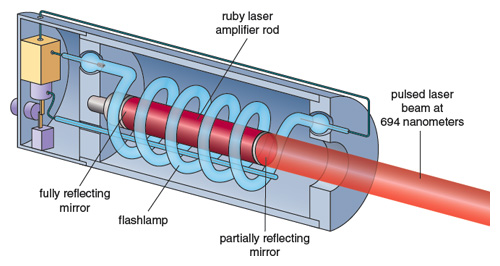
Illustration by Barbara Aulicino.
A laser is largely an amplifier, as the “a” in laser signifies: Light Amplification by Stimulated Emission of Radiation. As the latter part of the acronym implies, it works by pumping energy into electrons of atoms in some substance, called the gain material. These atoms can be assembled in a number of forms, and many different media suitable for lasers have been developed.
The active atoms or molecules in laser media can be in gaseous form, such as the neon atoms in the ubiquitous helium-neon laser known well to students in laboratory classes, or the carbon-dioxide molecules in many welding lasers. They can also be semiconductor materials, such as the gallium arsenide used in the diode (or solid-state) lasers of CD players. Or they can be embedded in crystals, such as the chromium ions in ruby, as Maiman used in his first laser.
In all forms, electrons in the atoms of the laser medium must be excited with energy. This feat is accomplished in many ways, such as by creating a high-voltage discharge in gases of the helium-neon laser, causing current to flow through the semiconductor of a diode laser, or shining light on crystals such as ruby with bright electric-arc lamps. It was this last approach that Maiman used in his first laser, where he surrounded a rod of ruby with a curled flashlamp.
When the electrons in a laser material’s atoms are excited, they can only acquire discrete energies, landing in specific quantum-energy levels. When the electrons are pushed to a higher quantum level, they can retain that energy for a period of time, called the “lifetime” of that level. When light at the right wavelength passes near these atoms within their lifetime window, the energy stored by the excited electron is extracted by stimulating the electron to drop back to a lower-energy quantum state. Thus the electron gives its energy to the passing light photons and effectively amplifies the passing light beam (see Figure 4). One can think about the laser as an energy-storage device, which releases previously stored energy into a beam or pulse of photons. If conditions are set up correctly, energy can be pumped into the electrons of the laser’s atoms over a long period of time (roughly the lifetime of the laser material’s excited-energy state), and then it can be released quickly, resulting in the production of a pulse of light with high peak power.
To accomplish this storage, the excited laser-gain material is placed between two mirrors—a construct known as an optical laser cavity—so that light circulates back and forth through the laser-gain medium, extracting the energy stored by electrons pumped into the upper quantum state. By coating the front faces of the laser-gain rod so that they reflected light (with a small amount allowed to leak out on one side to deliver the laser output), Maiman produced a light pulse from his first ruby laser with a duration comparable to that of his flashlamp light, about three milliseconds.
Shortly after the first laser demonstration, researchers realized that much shorter bursts could be produced from such a pulsed laser. If the energy stored in the upper quantum state of the laser could be extracted not over the duration of the pumping, but instead the extraction could be stopped for a while, stored energy will naturally build up in the laser medium. Then if a suitably fast switch were placed inside the cavity, all of this stored energy could be rapidly released in one light pulse. This idea was pursued within months of Maiman’s first demonstration by his colleagues, Fred J. McClung and Robert W. Hellwarth. They placed the ruby gain medium between two mirrors, and by temporarily interrupting the optical path between the two mirrors, energy could be pumped into the ruby and stored with increasing density by the electrons in upper quantum states. Then, when the interruption was rapidly removed, photons could circulate and quickly extract energy from the gain medium in a laser pulse.
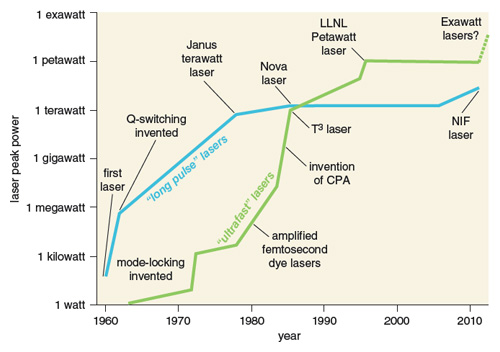
Illustration by Barbara Aulicino.
Instead of light energy coming out of the laser over the time period of the pumping, the energy was extracted on the time scale it took photons to circulate back and forth a few times in the now-unobstructed path between the two mirrors. Because the mirror spacing in such a laser is, say, 10 to 30 centimeters—corresponding to a transit time of one or two nanoseconds at the speed of light—the light pulse extracts the stored energy on this time scale, four to five orders of magnitude faster than the time over which the electrons are pumped.
In the parlance of electrical engineering, one can describe this process by saying that the quality factor of the optical cavity formed by the two mirrors, the “Q-factor,” is initially low. When the obstruction is removed and a clear optical path is formed, the Q-factor is quickly increased; thus the laser is “Q-switched,” allowing electromagnetic energy of the laser pulse to circulate with low losses. (The online version of this article contains a supplementary figure on Q-switching. See the box at the end of page 401 for a Web link to this issue.) The first Q-switched laser at Hughes was demonstrated in 1961. This laser delivered pulses of only 100 nanoseconds in duration, yielding a peak power near 1 megawatt, a jump in power by more than a factor of 1,000 over Maiman’s original device. Q-switching has since been implemented in many kinds of lasers, with particularly wide application in ones using crystals made of neodymium doped (or inserted) into yttrium- aluminum garnet (abbreviated Nd:YAG), as well as Nd doped into optical glass. A modern, commercial Q-switched Nd:YAG laser can deliver pulses of energy of up to 1 joule with a duration of 1 to 10 nanoseconds, yielding peak power approaching a gigawatt (109 watts).
To push this technology to higher pulse energy and, hence, higher power, one might naturally consider amplifying a nanosecond Q-switched laser pulse further by passing it through additional laser-gain media. This construct is known as the “master oscillator, power amplifier,” or MOPA, architecture. It has been used for many years in commercial Q-switched laser systems to yield laser pulses with many joules of energy. Soon such laser systems began to take up rooms and whole buildings.
In the early 1970s, the Lawrence Livermore National Laboratory (LLNL) in California began pursuing development of a series of increasingly larger lasers using the MOPA architecture, each more powerful than its predecessor. This development was motivated by the possibility of using high-energy laser pulses (of many tens or hundreds of kilojoules) to implode capsules and drive nuclear fusion in the lab (a technique known as inertial confinement fusion, or ICF). Because of the high energies produced, these lasers required increasing the aperture of the laser amplifier to larger sizes and the construction of systems with multiple MOPA beams. All of these systems utilized Nd-doped glass as the amplifier material because it was possible to fabricate glass into large apertures, up to many tens of centimeters.
LLNL’s ICF laser development spanned more than 40 years: The 100-joule Cyclops laser was constructed in 1974, followed by the two-beam Argus laser in 1976. The 20-beam, 10-kilojoule Shiva laser was constructed in 1977, representing the first large-facility-scale, high-power laser. Shiva was followed by the 100-kilojoule Nova laser in 1985. This line of development has culminated in recent years at LLNL with the demonstration in 2008 of the National Ignition Facility (NIF), a laser that delivers nanosecond pulses with energy combined from 192 separate beams that approaches 4 million joules—roughly a billion times more energetic and powerful than that first Q-switched laser.
Gas lasers have also been developed in a MOPA architecture for high-energy applications, including, for example, the construction of carbon-dioxide lasers at Los Alamos National Laboratory in the 1970s and 1980s, and the development at the Naval Research Laboratory of kilojoule- energy nanosecond lasers such as the Nike laser, which operates in the ultraviolet range using a gas of krypton fluoride. For high-energy nanosecond-laser amplification, however, Nd-doped glass has reigned as the king.
The story of increasing laser power did not end with the development of the Q-switched laser and the MOPA architecture. The second major breakthrough in the development of high-peak-power lasers occurred essentially in parallel with the invention of Q-switching. This important development, known as mode locking, was first demonstrated in the years immediately following the first laser. Mode locking revolutionized pulsed-laser technology, enabling the production of laser pulses that are orders of magnitude shorter than pulses produced by Q-switching. Mode-locked lasers yield pulses with time durations shorter than one picosecond down to only a few femtoseconds (10-15 seconds) in some cases.
This technique has fostered an entire subfield in optics devoted to the use of these ultrafast pulses to study physics and chemistry on timescales that were previous inaccessible. Ultrafast science is another of the exciting subplots in the story of the laser; it has led to remarkable insights into the way atoms move and molecules react, and work in this area received the Nobel Prize in Chemistry in 1999. Ultrafast laser-pulse generation by mode locking has also played a central role in the march to higher laser powers.
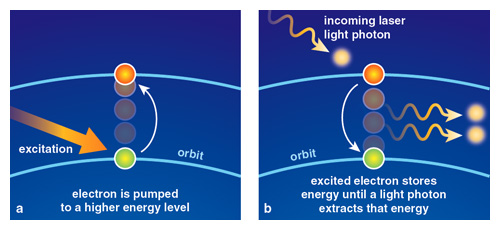
Illustration by Barbara Aulicino.
The Heisenberg uncertainty principle (which states that certain pairs of physical properties cannot simultaneously be known) applies to lasers and their electromagnetic waves. The principle mandates that, in order to generate light pulses with short durations, a broad bandwidth of frequencies must be present in the electromagnetic wave. One typically thinks of common lasers as having only one well-defined frequency, yielding the clear color we observe in visible lasers, such as the diode lasers used in laser pointers or argon lasers used in laser-light shows.
However, atoms in some laser media can amplify a rather broad range of frequencies in a laser cavity. This range varies with the atom or molecule and the environment in which it is placed. Consider a laser cavity with two opposing mirrors,. Many different light wavelengths can fit into the space between the mirrors, the only condition being that the wavelengths each must have an integral number of oscillations in the space between these mirrors. Each such electromagnetic wave is called a longitudinal “mode.”
When a pumped laser material is placed in this cavity, any modes with wavelength that fall into the range of frequencies that the material can amplify can thrive, and the device is said to lase “multimode.” For some laser-gain materials, this range of amplified modes can be very large, involving tens of thousands of modes. This result alone does not lead to a short pulse of light; it simply results in a continuous beam of laser light with a broad spectrum (and random spikes of energy in time, known as “mode-beating”).
The key to harnessing all of this laser-light bandwidth is to force all of these modes to oscillate with one well-defined phase; in other words, to cause all of the modes to march in lock step, so that peaks and troughs in the electromagnetic waves all have a fixed relationship to each other. When this is done, the modes are said to be locked. When each mode is summed with all the other modes, the sinusoidal electromagnetic waves add up to yield a short pulse in time, with duration roughly equal to the inverse of the frequency range of the modes that are amplified in the cavity. The observable consequence of this mode locking is the formation of a short light pulse that travels back and forth in the laser cavity, with a small amount of the light leaking out of one mirror on each round trip. A pulse much shorter in time than the round-trip time of the laser cavity can be formed.
Research over the years has led to a plethora of techniques to achieve this mode locking, most of which fall into one of two categories, active and passive mode locking. Active mode locking, which was demonstrated first, involves placing an optical material in the cavity that has its energy losses modulated in time by the application of an electrical signal, as is done in many Q-switched lasers. The optical losses induced by this modulator are varied at a repetition rate that matches the rate at which a mode-locked laser pulse circulates in the cavity. This forces the laser modes to lock so that only a short pulse is present to pass though the brief temporal window of the modulator device when its loss is low.
This active approach to mode locking relies on the property of a mode-locked laser to produce a pulse short in time; the other category of mode-locking relies on the fact that the peak intensity of the light in the cavity is much higher when mode-locked than when the cavity lases continuously. This passive mode-locking approach involves inserting a transmissive element in the cavity that has a loss that varies not in time but with light intensity. If this element absorbs light when the intensity is low, but its absorption drops when the intensity is high (or the absorption “saturates” with high intensity), the laser will be forced to fire in a way that minimizes losses—which occurs, again, when the modes are locked. Although the active approach was the first utilized, it is the second approach that has led to the generation of the shortest pulses and has served as the seed for the highest-power modern lasers.
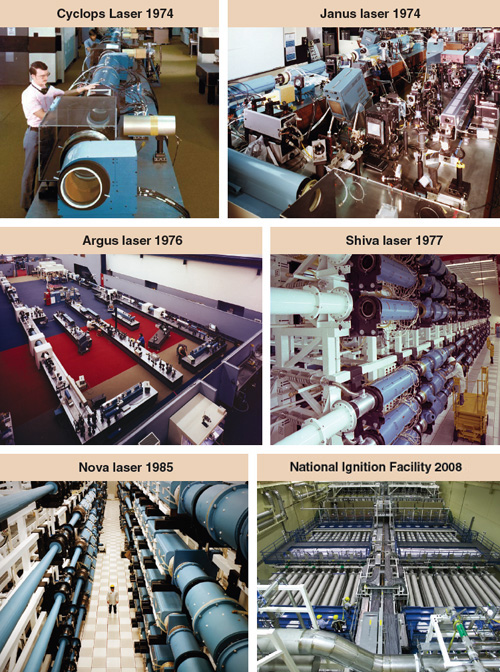
Remarkably, the first mode-locked laser was constructed in 1964, only four years after the first laser. This demonstration occurred at the Bell Telephone laboratories and involved mode locking a helium-neon laser, producing pulses of about one nanosecond in duration. Mode-locking technology then advanced rapidly. Mode-locked lasers using lamp-pumped, solid-state gain materials generated pulses of under 100 picoseconds by the late 1960s, followed by a further shortening in pulse duration in 1972 when the first continuous-wave, mode-locked dye laser was demonstrated by Erich P. Ippen, Charles V. Shank and Andrew Dienes. Laser dyes, which are typically dissolved in liquid and flowed through a container placed in a laser cavity, were developed initially in the late 1960s as gain media that allowed a laser to be tuned over a range of frequencies. It was this very broad-gain bandwidth that allowed dye lasers to generate pulses that broke through the 1-picosecond barrier, propelling ultrafast laser science into the femtosecond regime in the early 1980s. Indeed, in 1987, Shank and his coworkers demonstrated the production of laser pulses as short as 6 femtoseconds from a mode-locked dye laser, a record which stood for close to 15 years.
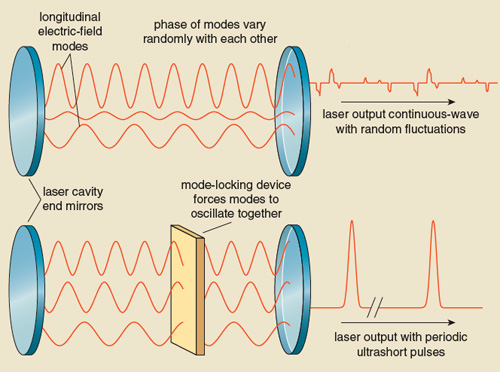
Illustration by Barbara Aulicino.
Another breakthrough in mode-locked technology has made possible the very highest-power lasers. This advance occurred in 1982 with Peter Moulton’s invention of titanium-doped sapphire crystals (Ti:sapphire) as a solid-state laser material. Ti:sapphire’s remarkable properties make it the laser material of choice for ultrafast lasers to this day. It has an extremely broad gain bandwidth, sufficient for pulses as short as 4 or 5 femtoseconds. And it has properties far superior to dyes: It is easy to work with as a solid-state crystal and can be fabricated with excellent optical quality. Mode-locked pulses shorter than 20 femtoseconds can be obtained easily in a Ti:sapphire laser using a passive mode-locking technique, known as Kerr lens mode-locking, which was discovered, almost by accident, in 1990 in the lab of Wilson Sibbett at the University of St. Andrews in Scotland. Since 1982 there have been a number of other crystals discovered (both natural and human-made) that have similar suitable properties. Mode-locked Ti:sapphire lasers, however, remain the standard tool for the ultrafast laser scientist.
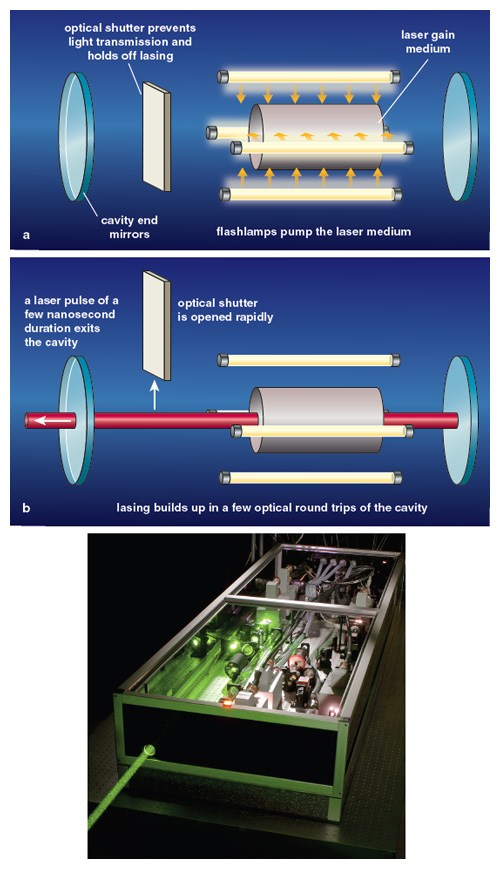
Illustration by Barbara Aulicino. Photo courtesy of Continuum, Inc., photography by Evan Winslow Smith
The impact that these ultrafast laser sources could have on the development of compact, high-peak-power lasers was realized shortly after the demonstration of mode-locking. Because peak power in a pulse of given energy is increased by decreasing the pulse duration, amplifying further the short pulses produced by a mode-locked laser was a path to making compact, higher-power lasers. The obvious approach here is to send a short pulse from a mode-locked laser into a MOPA amplifier chain. It was this approach that led to the first trillion-watt (1 terawatt) laser, which occurred on the Janus laser in 1975 at LLNL. Mode-locked pulses of roughly 100 picoseconds in duration were amplified to an energy of about 100 joules in a Nd:glass amplifier chain. Even shorter pulse-amplified lasers were constructed employing laser dyes to further amplify the femtosecond pulses from a mode-locked dye laser. This approach led to the demonstration of tabletop-scale lasers in the early 1980s, with peak power of greater than a gigawatt and pulse duration of under 1 picosecond.
Pushing this approach to higher power levels ultimately has a limitation. For a given beam aperture, the peak intensity of the laser pulse grows as it passes through the amplifiers. When this intensity gets high enough, a number of nonlinear effects alter the pulse in ways that give high-power laser designers nightmares. The largest problem comes from the fact that the refractive index of any material (the rate at which it bends light), including those used to amplify a laser pulse, increases very slightly as the intensity of light is amplified. For light intensity encountered in most everyday situations, this variation of refractive index is completely ignorable. But as one amplifies short laser pulses to high energy, this phenomenon can lead to catastrophic consequences.
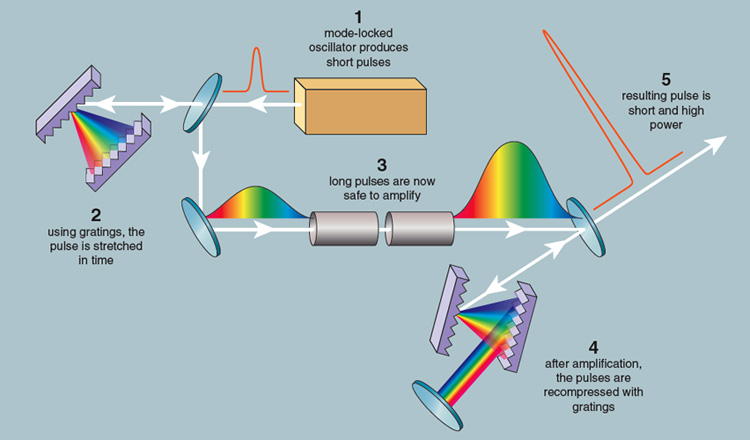
Illustration by Barbara Aulicino.
Any real beam of light will inevitably have small modulations of intensity on its spatial profile, the natural result of imperfections in real optics. Because the refractive index increases with intensity, the center and most intense parts of these little beam modulations will see a slightly higher refractive index, which effectively slows down the phase of the electromagnetic wave there. This leads to a curved, concave wavefront around this intensity ripple, which causes focusing. As this now-focusing ripple propagates, its intensity further increases, and the center of the modulation is retarded even more by the changing refractive index. This process can continue until these ripples focus to small spots and reach an intensity high enough that the optics in the laser chain are damaged.
This so-called “small-scale self- focusing” can lead to spectacular failure of laser optics, as an intense beam will break apart into a shotgun blast of ripples, drilling hundreds of tiny holes in the expensive optics of a high-power laser. Until the mid-1980s it was assumed that the only way to defeat this problem and push to higher laser power was to make the beam aperture larger and larger, limited ultimately by the cost and technology of very large optics.
An elegant solution to circumvent this problem was invented in 1985. Working at the time at the University of Rochester, Gerard Mourou, aided by his graduate student Donna Strickland, demonstrated a solution to the nonlinear damage problem that has since revolutionized high-peak-power, ultrafast lasers. Their solution took advantage of the fact that an ultrafast laser pulse is composed of a range of wavelengths. They introduced a sequence of optics, such as prisms or diffraction gratings that spread the colors of the pulse spatially, just as raindrops do to the light from the Sun when making rainbows. These optical devices make it possible to manipulate these colors in time, essentially by designing the optical system so that each color travels a different path length. This yields a pulse that is spread out in time with a duration far longer than the initial ultrashort laser pulse, and with the frequencies of the pulse dispersed in time, just as the rise in tone of an audible “chirp” from a bird arrives at our ear as a sweep in audio frequency.
Mourou’s beautiful idea was to perform such optical chirping on an ultrafast laser pulse before it was amplified, thereby making it much longer, many hundreds of picoseconds, and low enough in intensity that it is safe to amplify without the need for exorbitantly large optics. After amplification, the spread of colors in time is simply reversed, using the same devices, now arranged so that the colors that were initially delayed arrive back at the same time as the early colors. This process recompresses the pulse to nearly the same short duration as the initial pulse from the mode-locked laser, but with the high energy that a MOPA chain can supply.
Using this “Chirped-Pulse Amplification,” or CPA, technique, Strickland and Mourou demonstrated a compact, tabletop laser system with pulses of a picosecond in duration with amplified power of nearly 100 gigawatts, a power achieved at that time only by large-aperture, national-laboratory-scale lasers. This demonstration led to an explosive growth in the peak power available from lasers in the laboratory and an incredible proliferation of high-power lasers into research labs around the world. Within three years after that first demonstration of CPA, Mourou and his colleagues demonstrated a compact laser delivering greater than 1 terawatt of peak power, a system Mourou coined the “Table Top Terawatt” or “T-cubed.”
CPA technology was quickly implemented into a series of higher-power lasers around the world, including an array of lasers with tens of terawatts of power at large labs such as LLNL, the Commissariat à l’Énergie Atomique laboratory at Limeil in France and the Institute for Laser Engineering at Osaka in Japan. The scientific drive for building these high-power CPA lasers has been a desire to study the physics of light interactions with matter at higher and higher intensity. The intensity that can be created with modern multiterawatt CPA lasers is remarkable: When focused to a spot of a few micrometers, the intensity of the laser pulse exceeds the intensity of sunlight on the Earth by 18 or 19 orders of magnitude. What happens to matter in light of this intensity is a major scientific question. For example, how this intense light ionizes atoms has become a topic of active research, and much understanding about “strong field” physics has been gained with the advent of these lasers.
Also interesting are the plasmas (clouds of ionized gas) at very high temperatures that can be created when such an intense laser pulse is focused into a gas or onto a solid. Plasmas with temperatures of millions of degrees Celsius can be created. These temperatures can potentially be used to spark controlled nuclear fusion in the lab, or can recreate conditions that are normally found only in the depths of enigmatic astrophysical objects such as brown dwarfs or supernovae.
Multiterawatt, ultrashort-pulse lasers were at first all constructed of amplifiers using Nd:glass. But because Ti:sapphire can amplify light in a very broad band of frequencies, it was soon exploited to create CPA lasers, which could amplify pulses that are then recompressed to durations as short as 30 femtoseconds. Since the first implementation of Ti:sapphire in CPA lasers at laboratories at the University of Michigan and Stanford University around 1990, Ti:sapphire has become by far the most prevalent material for high-peak-power CPA lasers. They are now used worldwide for research not only in strong-field atomic physics and high-intensity plasma physics, but also in ultrafast chemistry and a host of applications as diverse as biological imaging and precision machining.
Despite the prevalence of Ti:sapphire in the widespread proliferation of CPA lasers, Nd:glass remained the amplifier material that could be used to create the highest laser powers. The 100-terawatt power barrier was broken by a Nd:glass CPA system at LLNL in 1995. This record was then shattered little more than a year later by a team at LLNL led by Michael Perry. Using a beamline of the Nd:glass Nova laser, the team used CPA to produce laser pulses with 500 joules of energy recompressed to a duration of about 400 femtoseconds. This outcome yielded for the first time peak powers exceeding 1 petawatt, a quadrillion watts. Laser power at this level exceeds the power release of any other human-made object (including the detonation of a nuclear weapon), and represents a power level 2,000 times the power output of all the electrical generation plants in the United States. (A typical electrical power plant delivers power of 1 to 2 gigawatts.)
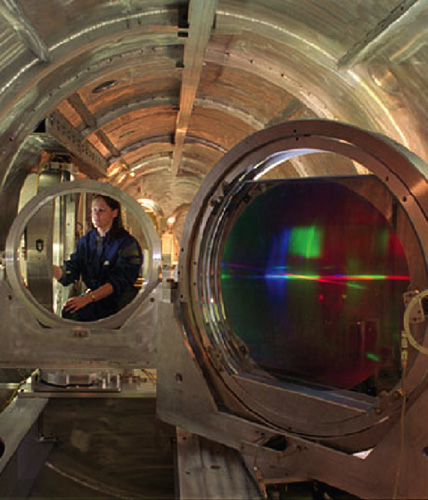
Photo courtesy of Lawrence Livermore National Laboratory.
Perry’s petawatt laser was an amazing tour-de-force of high-power laser technology. To compress such a pulse, for example, diffraction gratings nearly 1 meter in size were needed—almost 10 times the size of gratings that were available at that time. This required a massive development effort in grating technology at LLNL that has since spun off many applications. The focused intensity of the Petawatt laser neared 1021 watts per square centimeter, an unprecedented light intensity that led to a range of interesting discoveries, for instance about nuclear fusion and the fundamental properties of matter, while the Livermore Petawatt laser operated through the late 1990s.
The past 10 years have seen an improvement on the initial technology of the LLNL petawatt laser and have led to the construction of a number of petawatt-class lasers worldwide. These include lasers with powers above 1 petawatt at the Vulcan laser facility in England and our development of the Texas Petawatt laser at the University of Texas at Austin. New technology has improved the quality of lasers at this power level and has shortened the compressed pulse in a Nd:glass CPA laser to durations near 100 femtoseconds, four times shorter than the first ones at LLNL and 10 times shorter than the first CPA laser. Petawatt-class lasers now operate in Osaka, Japan; at the Laboratory for Laser Energetics in Rochester; and at Sandia National Laboratory in New Mexico.
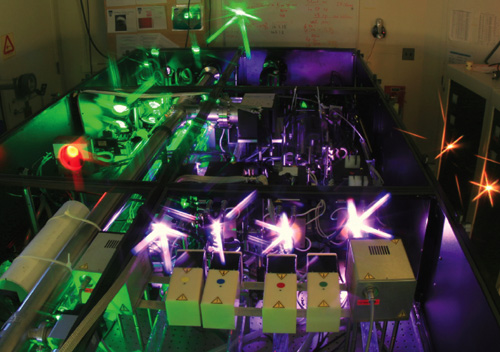
Photograph courtesy of Victor Yanovsky, University of Michigan.
The past decade has also seen the development of Ti:sapphire CPA technology in petawatt-class lasers with much shorter pulses (20 to 50 femtoseconds) at laboratories such as the Japanese Atomic Energy Research Institute near Kyoto, Japan, and at the Laboratoire d’Optique Appliquée in France, as well as at LLNL. These petawatt-laser systems are used in a host of exciting research areas, such as in the acceleration of protons for potential use in cancer therapy, or the production of electron beams with energies approaching those of modern large-scale particle accelerators.
Though CPA technology continues to improve, the peak power of lasers since 2000 has not risen beyond the 1-petawatt level. This ceiling is likely to change in the coming decade. The development of CPA technology both with Ti:sapphire and Nd:glass, which allows amplification of high-energy pulses with durations below 100 femtoseconds, has made the prospect of lasers with far greater peak powers likely. Plans to design and build a laser facility with a power of 200 petawatts are advancing in Europe at a rapid pace, under a European Union–supported program known as the Extreme Light Infrastructure project. Plans to develop an exawatt laser (1,000 petawatts, or one quintillion watts), are also forming in this country. The U.S.–based approach uses well-established Nd:glass CPA architecture, implemented with new kinds of laser glass that may allow amplification of pulses as short as 50 femtoseconds. The science that can be explored with such remarkably powerful machines has yet to be fully assessed. But as the scientific case for these exawatt-class systems grows in the coming years, it is likely that the stunning rise in laser-pulse peak power made possible by that first, modest ruby laser 50 years ago will continue.
Click "American Scientist" to access home page
American Scientist Comments and Discussion
To discuss our articles or comment on them, please share them and tag American Scientist on social media platforms. Here are links to our profiles on Twitter, Facebook, and LinkedIn.
If we re-share your post, we will moderate comments/discussion following our comments policy.